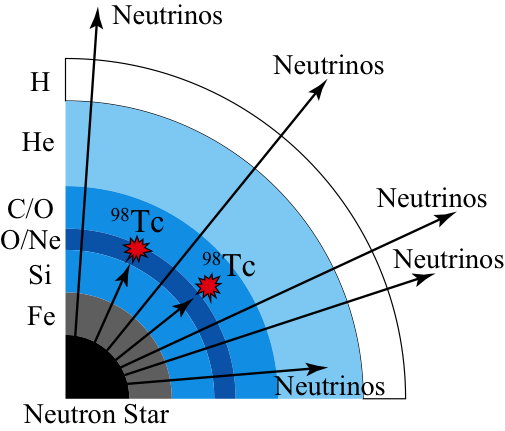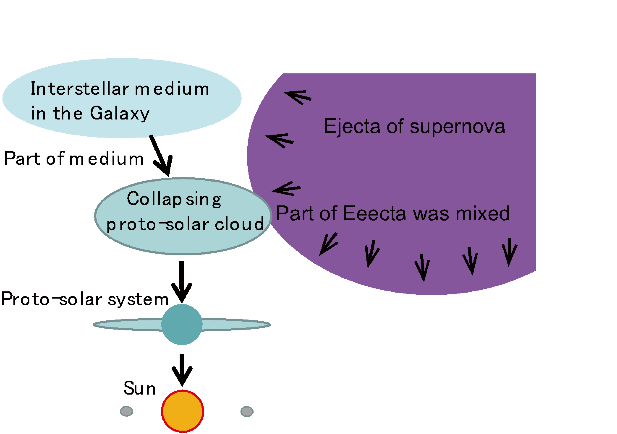September 5, 2016
Kavli Institute for the Physics and Mathematics of the Universe (Kavli IPMU)

A team of researchers has theoretically predicted that an unstable isotope Technetium-98 (98Tc) could be synthesized by neutrinos emitted from supernova explosions.
A large number of neutrinos are emitted from the proto-neutron star formed during an early phase of a core-collapse supernova. When these neutrinos pass through the outer layers, they partially deposit their energy in the outer layers, leading its supernova explosion. In the outer layers, some nuclides such as Tantalum-180 are newly synthesized by the neutrino-nucleus interaction. There are six neutrino species, electron neutrino, muon neutrino, tau neutrino, and their anti-neutrinos.

At the present study, first, it was found the possibility that 98Tc may be synthesized by the neutrino process.
Next, the expected 98Tc abundance was calculated using a supernova explosion model with the neutrino-nucleus interactions involved.
As a result, it was found that 98Tc neutrino-process nucleosynthesis is the large contribution (∼20%) from charged current reactions with electron anti-neutrinos. It was shown that if the initial abundances of 98Tc were to be precisely measured, the 98Tc nuclear cosmochronometer could be used to evaluate the initial abundance of 98Tc and the duration time from the last core-collapse supernova to the formation of the solar system.
The present result is also important for the average temperatures of the six neutrinos and astronomical observation of the electron anti-neutrino.
This work was published in Physical Review Letters this week.
Click here to view the press release from the National Institutes for Quantum and Radiological Science and Technology.
Paper details
Journal: Physical Review Letters
Title: Short-lived radioisotope 98Tc synthesized by the supernova neutrino process
Authors: Takehito Hayakawa (1, 2), Heamin Ko (3), Myung-Ki Cheoun (3), Motohiko Kusakabe (4), Toshitaka Kajino (2, 4, 5), Mark D. Usang (6), Satoshi Chiba (6), Ko Nakamura (7), Alexey Tolstov (8), Ken’ichi Nomoto (8), Masa-aki Hashimoto (9), Masaomi Ono (10), Toshihiko Kawano (11), Grant J. Mathews (12)
Author affiliations:
1. National Institutes for Quantum and Radiological Science and Technology, 2-4 Shirakata, Tokai, Naka, Ibaraki 319-1106, Japan
2. National Astronomical Observatory of Japan, Mitaka, Tokyo 181-8588, Japan
3. Soongsil University, Seoul 156-743, Korea
4. Beihang University, Beijing 100191, China
5. The University of Tokyo, Bunkyo-ku, Tokyo 113-0033, Japan
6. Tokyo Institute of Technology, 2-12-1 Ookayama, Meguro, Tokyo 113-0033, Japan
7. Fukuoka University, 8-19-1 Nanakuma, Jonan-ku, Fukuoka 814-0180, Japan
8. Kavli Institute for the Physics and Mathematics of the Universe (WPI), The University of Tokyo, 5-1-5 Kashiwanoha, Kashiwa, Chiba 277-8583, Japan
9. Kyushu University, Hakozaki, Fukuoka 812-8581, Japan
10. RIKEN, 2-1 Hirosawa, Wako-shi, Saitama 351-0198, Japan
11. Theoretical Division, Los Alamos National Laboratory, Los Alamos, NM 87545, USA
12. University of Notre Dame, Notre Dame, IN 46556, USA
DOI: 10.1103/PhysRevLett.121.102701 (Published September 4, 2018)
Paper link (abstract) https://journals.aps.org/prl/abstract/10.1103/PhysRevLett.121.102701






